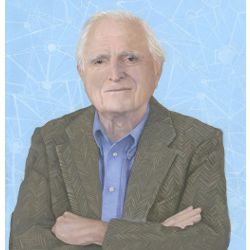
"Inspiring," "visionary," "humble," "honest," "impeccable integrity," "passionate and stubborn about his work."
Tributes poured in for Douglas Engelbart, inventor of the computer mouse and an Internet pioneer, following his death from kidney failure July 2 at his home in Atherton, CA. People from all echelons of the technology community extolled Engelbart’s enduring legacy and hailed his more than six decades of work in computer research and inventions as not just innovative technology, but as mechanisms that could transform the world and solve society’s problems.
"Doug once said the least-important things he did were his inventions, such as the mouse," recalls Alan Kay, president of the Viewpoints Research Institute (VRI), a nonprofit public benefit organization on whose Board of Advisors Englebart served. "What was most important [to him] was what he was trying to improve, and how he was trying to improve it," Kay said.
Kay said many of Engelbart’s key contributions had to do with how ideas and actions can be synergistically intercommunicated and constructed into better forms and processes with the aid of technological amplifiers.
Engelbart’s technology vision attracted a devoted coterie of engineers who shared his philosophy. "Doug had more technical groupies than anyone I have ever known. He touched and inspired people way beyond technology," recalled Curtis Carlson, chief executive officer at SRI International, where Engelbart held one of his first technology jobs. "His impact and legacy are still felt at SRI today."
"No one before Doug thought about the customer experience and the impact it would have on corporations and hundreds of millions of people worldwide," Carlson said. "There would be "no Apple or Xerox PARC without Doug Engelbart. …It was a magic moment when Steve Jobs intercepted Doug Engelbart at exactly the right time and started using the computer mouse."
Kay, the 2003 A.M. Turing Award recipient, said Engelbart—the man and his work—had a profound influence on him. "Doug had some of the most significant insights about humans, and about how solving some of our most important human problems could be aided/augmented by the visionary use of computers."
In the 1960s, Kay witnessed Engelbart’s now-famous "Mother of All Demos" presentation of interactive computing designed to support collaborative work groups. "Doug inspired funders and computer people to combine to make a series of ‘living lab’ systems that both could demo some of the ideas, and were also engineered and fleshed out well enough to be put into daily use," Kay said.
Logitech CEO Guerrino de Luca considered Engelbart "one of the most under-recognized geniuses of our times," even though he received the ACM A.M. Turing Award in 1997, and received the National Medal of Technology and Innovation from President Bill Clinton in 2000. Despite these awards and any measure of recognition he managed to achieve, "Doug stayed humble, curious, and accessible to ideas and people all his life," de Luca said.
Distinguished Career
Engelbart joined SRI (then known as Stanford Research Institute) in the 1960s. His first assignment was working on magnetic devices and the miniaturization of electronics; he eventually received more than a dozen patents for his work. At SRI, Engelbart founded the Augmentation Research Center (ARC), where he and a team of about a dozen engineers focused on developing new collaboration and information processing tools. He and his team, which included lead engineer Bill English, developed bitmapped screens, the computer mouse, hypertext, and initial steps toward the graphical user interface.
Engelbart and his team became known for their intensity, devotion, and committed work ethic. They had endless discussions and debates and were willing to work 12- and 15-hour days, Carlson said. "In 2013, when we have the Internet and ubiquitous connectivity, it is not uncommon, but in the context of the 1960s work ethos where a 9-to-5 workday was the accepted norm, it was unheard of," he noted.
Engelbart was well liked and respected by executives, colleagues, and those who worked for him. "He was soft-spoken, friendly, and approachable," Carlson recalls.
Transformative Power
Everyone interviewed for this article said Engelbart was extremely tenacious, which worked both for and against him. Early in his career, Englebart’s passion for his work and ideas had investors flocking to fund him; by the 1980s, however, he struggled to find backers.
"His biggest quirk was being stubborn and trying to stay 100 years ahead of everyone," Carlson said.
Kay said one of the great ironies of Engelbart’s later career was that "He had a harder and harder time getting heard, because he stayed with his message."
Ultimately, "visionary" was the word used most often to describe Engelbart.
Carlson claimed that in addition to his renowned "Mother of All Demos," Engelbart originated the concept that technology speed and performance double every two years, famously known as Moore’s Law after Intel Corp. co-founder Gordon Moore. "Doug was the first person who gave a talk about the performance scaling law for integrated systems," Carlson asserted.
De Luca said Engelbart’s vision "of bootstrapping Collective IQ, his passion in life, was a 50-year-plus vision. His belief that technology is the key to mankind’s ability to solve difficult problems collectively has the transformative power that few others share."



Join the Discussion (0)
Become a Member or Sign In to Post a Comment